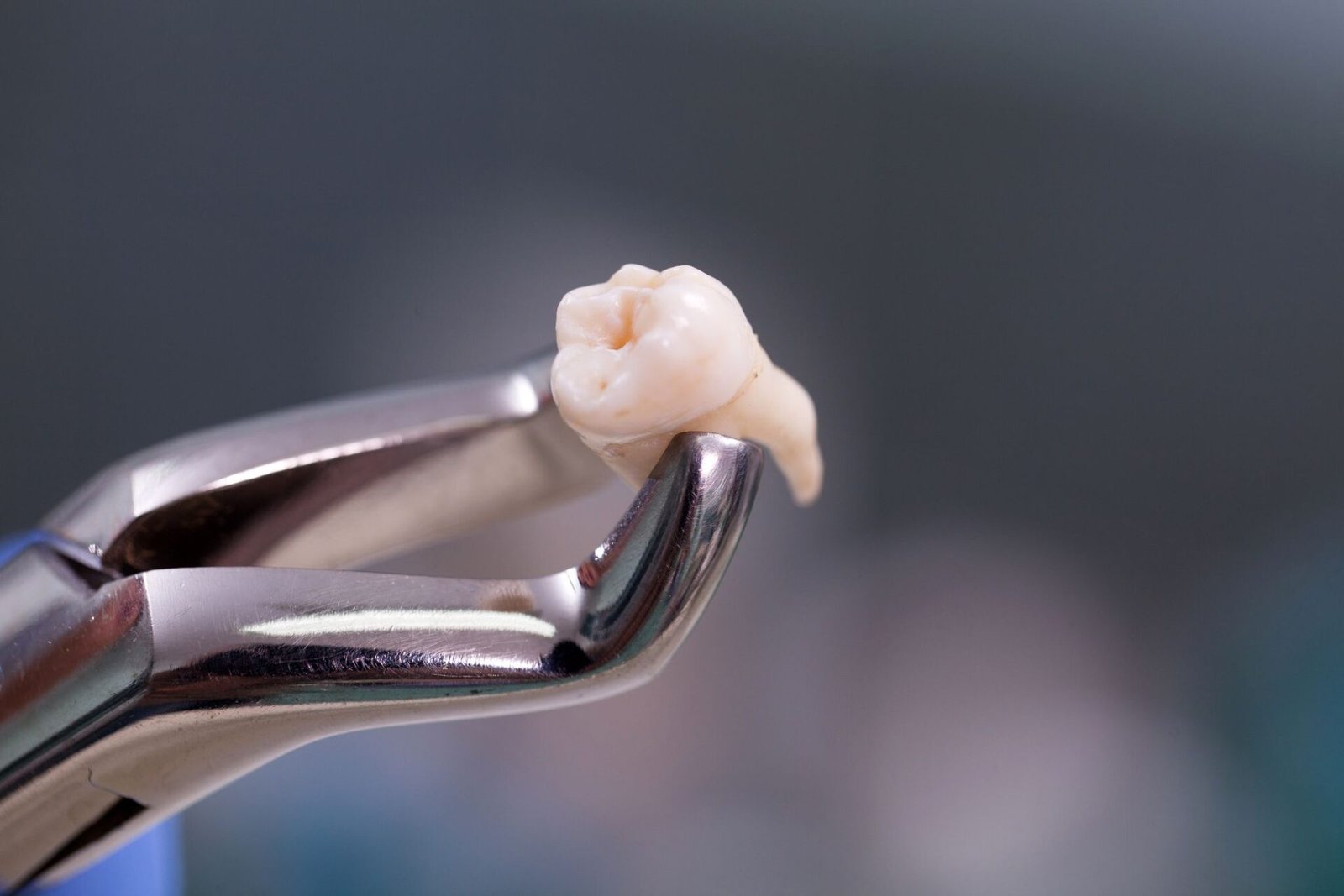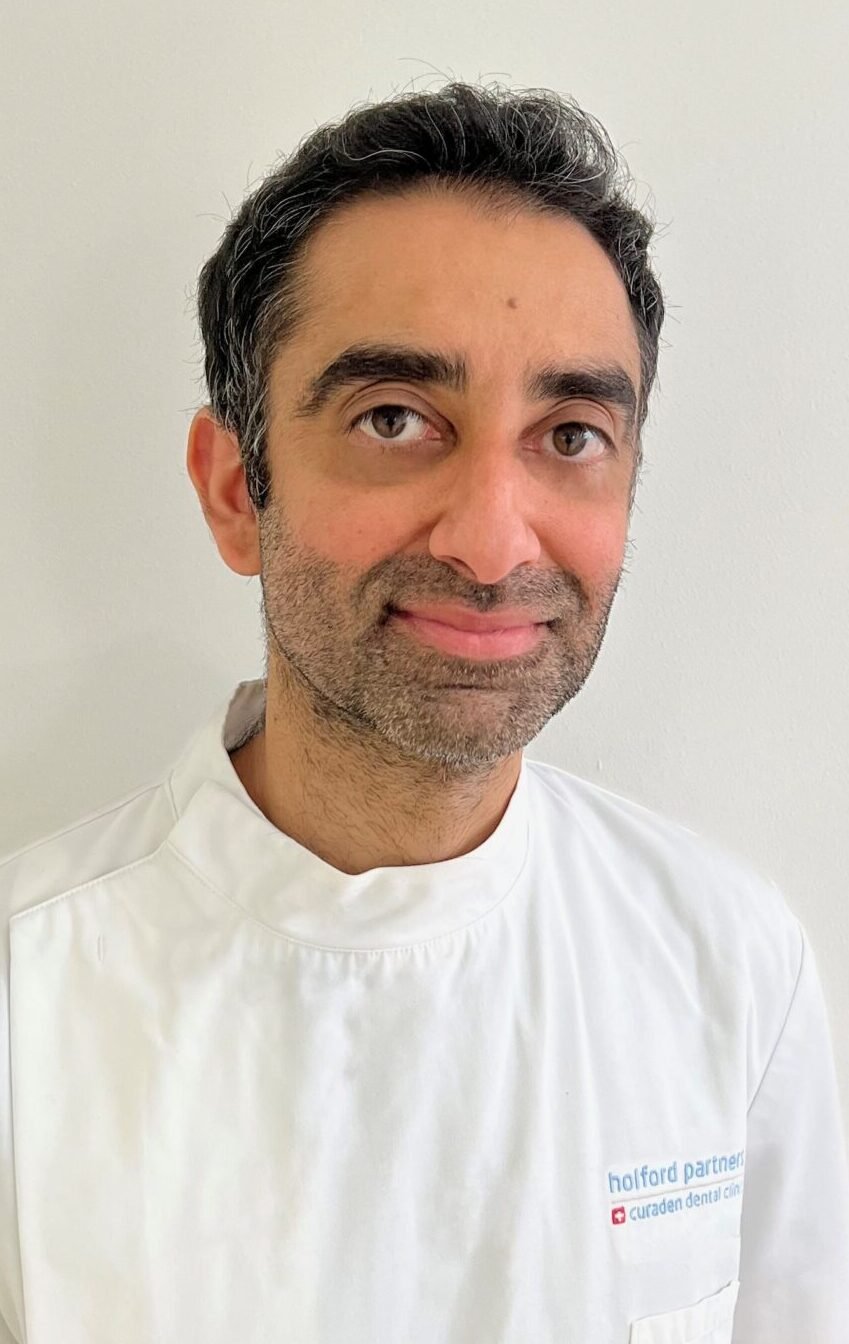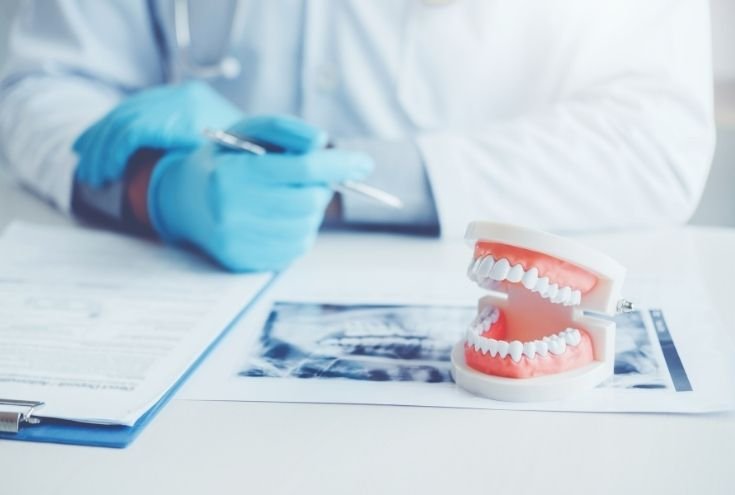
Tooth Extraction
At Holford Curaden, we understand that a tooth extraction can feel overwhelming, but our expert dental team is here to ensure the process is as smooth and comfortable as possible.
Whether you need a single tooth removed or a complex procedure like wisdom tooth extraction, we are committed to providing exceptional care in a welcoming environment.

What is a Tooth Extraction?
A tooth extraction involves removing a tooth from its socket in the bone. While we prioritize preserving your natural teeth through restorative treatments, there are situations where an extraction is necessary to safeguard your overall oral health. Some of the most common reasons for tooth extractions include:
- Severe Tooth Decay or Infection: When decay or infection becomes too advanced to be treated with a filling, crown, or root canal, removing the affected tooth can prevent the spread of infection.
- Advanced Gum Disease: Periodontal disease can weaken the supporting structures of your teeth, causing them to loosen. Extraction may be the best solution to maintain oral health.
- Crowded Teeth: For orthodontic treatments, removing one or more teeth may be needed to create sufficient space for proper alignment.
- Impacted Wisdom Teeth: Wisdom teeth that don’t fully erupt or grow at an angle can lead to pain, swelling, and infection, requiring surgical removal.
- Trauma or Injury: Teeth that are fractured beyond repair from accidents or injuries may need extraction.
Types of Tooth Extraction
At Holford Curaden, we provide two main types of tooth extraction to meet your specific needs:
- Simple Tooth Extraction: This procedure is performed on teeth that are fully visible in the mouth. It’s a straightforward process typically completed under local anaesthesia for a painless experience.
- Surgical Tooth Extraction: For teeth that are partially or fully impacted, broken beneath the gum line, or otherwise challenging to access, we offer surgical extractions. These procedures involve making a small incision in the gum and are often performed using advanced tools to ensure precision and comfort.
Our Gentle Approach
Your comfort and well-being are at the heart of our care. We use the latest techniques and technology to minimize discomfort and promote fast recovery. For patients feeling anxious, we offer sedation options to ensure a stress-free experience.
Why Choose Holford Curaden for Your Tooth Extraction?
- Our dentists bring extensive expertise and precision to every procedure.
- We use state-of-the-art equipment in a clean, modern environment.
- Personalised care ensures each patient’s unique needs are met.
- Flexible scheduling includes emergency appointments, so help is available when you need it most.
From simple to complex extractions, you can trust our team to provide professional care with a gentle touch.
What Will Happen During the Tooth Extraction Procedure?
1. Preparation
Before the extraction, your dentist will review your medical history and current medications. If necessary, X-rays will be taken to assess the tooth’s position and the surrounding bone. This helps determine the most effective method for the extraction.
2. Anaesthesia
Your comfort is a top priority. The dentist will administer local anaesthesia to numb the tooth and surrounding area, ensuring you feel no pain during the procedure. For patients with anxiety or for complex extractions, sedation options, such as oral sedation, nitrous oxide (laughing gas), or intravenous sedation, may be offered.
3. The Extraction Process
- Simple Extractions:
For teeth visible above the gum line, the dentist will use an instrument called an elevator to loosen the tooth gently. Forceps are then used to remove the tooth from its socket. - Surgical Extractions:
For impacted or broken teeth, a small incision may be made in the gum to access the tooth. In some cases, the tooth may be sectioned into smaller pieces to facilitate its removal. Surgical extractions are often required for wisdom teeth or severely decayed teeth.
4. Managing Bleeding
After the tooth is removed, the dentist will clean the socket to remove debris and ensure proper healing. A gauze pad will be placed over the site, and you’ll be asked to bite down to control bleeding and help form a blood clot.
5. Stitches (If Required)
For surgical extractions, the dentist may place dissolvable stitches to close the incision and promote faster healing. These stitches typically dissolve on their own within a week or two.
6. Aftercare Instructions
Once the procedure is complete, you’ll be given detailed aftercare instructions. These include how to manage bleeding, reduce swelling, and care for the extraction site to prevent complications like dry socket.
Tooth Extraction Aftercare
Proper aftercare is essential to ensure a smooth recovery. Here are some key tips:
- Bite down on gauze to control bleeding.
- Avoid rinsing or spitting forcefully for the first 24 hours.
- Stick to soft foods and avoid chewing near the extraction site.
- Use ice packs to reduce swelling.
- Take prescribed medications as directed.
- Avoid smoking and alcohol, as they can delay healing.
- Keep your head elevated while resting to reduce bleeding and swelling.
- Rinse gently with warm salt water after the first 24 hours to keep the area clean.
Maintaining Oral Health After an Extraction
After your extraction, maintaining good oral hygiene and following up with your dentist are crucial. Here are some additional tips:
- Regular Check-ups: Schedule follow-up appointments to ensure proper healing.
- Healthy Diet: Eat a balanced diet rich in vitamins and minerals to support recovery.
- Oral Hygiene: Continue brushing and flossing, avoiding the extraction site initially, to keep your mouth clean and prevent infection.
- Replacing Missing Teeth: Discuss options like dental implants or bridges to restore function and appearance after healing.
If you experience any complications, such as prolonged pain, swelling, or signs of infection, contact us immediately.
When a tooth extraction is part of a broader treatment plan, it often integrates with other dental procedures to ensure optimal oral health, function, and aesthetics. Here are the most common combination treatments available:
1. Orthodontic Preparations
In cases of overcrowded teeth, extractions may be necessary to create space for proper alignment.
- Extractions are often recommended before starting orthodontic treatments like braces or clear aligners if there is insufficient room in the jaw to align teeth correctly.
- After removing the tooth, your orthodontist can begin shifting your remaining teeth into their ideal positions using braces or aligners.
- This ensures that your final smile is both aesthetically pleasing and functionally healthy, preventing complications like misaligned bites or overlapping teeth.
2. Dental Implants
After a tooth extraction, replacing the missing tooth is crucial to prevent bone loss and maintain proper oral function. Dental implants are a durable and natural-looking solution.
- Implants are ideal for patients looking to replace one or more missing teeth after healing from an extraction.
- Immediate Implant Placement: In some cases, an implant can be placed directly after the extraction.
- Delayed Implant Placement: For complex cases or insufficient bone, implants may be placed after several months of healing.
- Dental implants prevent bone resorption, maintain facial structure, and restore the ability to chew and speak effectively.
3. Bone Grafting
Bone grafting is often combined with extractions, especially if you’re planning for dental implants.
- If significant bone loss has occurred due to gum disease, trauma, or tooth decay, a bone graft may be required to build up the jawbone.
- During the tooth extraction, the dentist may place bone graft material into the socket to preserve or enhance the bone structure. This helps ensure a strong foundation for future implants.
- A successful graft prevents further bone loss and allows for the secure placement of implants later.
4. Periodontal Therapy
If gum disease is a factor leading to a tooth extraction, addressing gum health is critical to prevent further issues.
- If gum disease has caused severe damage to teeth or surrounding tissues, extractions may be combined with periodontal treatments to stabilize oral health.
- After the extraction, deep cleaning techniques like scaling and root planning or more advanced procedures like gum grafting may be recommended to restore gum health.
- This approach ensures that the rest of your teeth and gums remain healthy, reducing the risk of future teeth needing to be extracted.
5. Full Mouth Rehabilitation
For patients with multiple missing or damaged teeth, extractions may be part of a larger restorative treatment plan.
- Patients with advanced dental issues may require a combination of extractions, implants, crowns, and bridges to restore their smile.
- After extractions, the dentist will design a personalised treatment plan to replace missing teeth and address alignment, function, and aesthetics.
- A full mouth rehabilitation not only improves oral health but also enhances confidence and quality of life.
6. Wisdom Tooth Extractions and Jaw Alignment
Impacted or problematic wisdom teeth may affect the alignment of your jaw and other teeth. Removing these teeth can prevent or resolve such issues.
- Wisdom tooth extractions are often combined with orthodontic treatments or to alleviate symptoms like crowding, pain, or infections.
- Surgical extraction of wisdom teeth followed by orthodontic or jaw alignment treatments ensures a balanced bite and comfortable chewing function.
- This approach protects the long-term health of adjacent teeth and jaw alignment.
7. Temporary Solutions: Dentures and Bridges
If dental implants are not an immediate option, temporary or permanent dentures or bridges can be used after tooth extractions.
- When multiple teeth are removed and immediate replacements are necessary to maintain function and aesthetics.
- After healing, dentures or fixed bridges can replace the missing teeth. In some cases, temporary solutions are provided until implants or permanent options are ready.
- This ensures that patients can continue to eat, speak, and smile confidently during the healing period.
How much do Tooth Extractions cost?
Prices may vary as sometimes extra bone graft materials are required to provide a good bone foundation for the implant placement. Sometimes a CBCT scan (Cone Beam Computed Tomography) is required to show a 3D image of the tooth in relation to the bone levels, roots and nerves to rule out any potential complications.
TOOTH EXTRACTION ……………….. from £250 – £650
BONE GRAFT MATERIALS ……………….. from £250
SEDATION ……………….. from £250
Prices may be subject to change. For more information please feel free to contact us on 020 7499 9806 or at smile@holfordcuraden.com
What is a Tooth Extraction?
A tooth extraction involves removing a tooth from its socket in the bone. While we prioritize preserving your natural teeth through restorative treatments, there are situations where an extraction is necessary to safeguard your overall oral health. Some of the most common reasons for tooth extractions include:
- Severe Tooth Decay or Infection: When decay or infection becomes too advanced to be treated with a filling, crown, or root canal, removing the affected tooth can prevent the spread of infection.
- Advanced Gum Disease: Periodontal disease can weaken the supporting structures of your teeth, causing them to loosen. Extraction may be the best solution to maintain oral health.
- Crowded Teeth: For orthodontic treatments, removing one or more teeth may be needed to create sufficient space for proper alignment.
- Impacted Wisdom Teeth: Wisdom teeth that don’t fully erupt or grow at an angle can lead to pain, swelling, and infection, requiring surgical removal.
- Trauma or Injury: Teeth that are fractured beyond repair from accidents or injuries may need extraction.
Types of Tooth Extraction
At Holford Curaden, we provide two main types of tooth extraction to meet your specific needs:
- Simple Tooth Extraction: This procedure is performed on teeth that are fully visible in the mouth. It’s a straightforward process typically completed under local anaesthesia for a painless experience.
- Surgical Tooth Extraction: For teeth that are partially or fully impacted, broken beneath the gum line, or otherwise challenging to access, we offer surgical extractions. These procedures involve making a small incision in the gum and are often performed using advanced tools to ensure precision and comfort.
Our Gentle Approach
Your comfort and well-being are at the heart of our care. We use the latest techniques and technology to minimize discomfort and promote fast recovery. For patients feeling anxious, we offer sedation options to ensure a stress-free experience.
Why Choose Holford Curaden for Your Tooth Extraction?
- Our dentists bring extensive expertise and precision to every procedure.
- We use state-of-the-art equipment in a clean, modern environment.
- Personalised care ensures each patient’s unique needs are met.
- Flexible scheduling includes emergency appointments, so help is available when you need it most.
From simple to complex extractions, you can trust our team to provide professional care with a gentle touch.
What Will Happen During the Tooth Extraction Procedure?
1. Preparation
Before the extraction, your dentist will review your medical history and current medications. If necessary, X-rays will be taken to assess the tooth’s position and the surrounding bone. This helps determine the most effective method for the extraction.
2. Anaesthesia
Your comfort is a top priority. The dentist will administer local anaesthesia to numb the tooth and surrounding area, ensuring you feel no pain during the procedure. For patients with anxiety or for complex extractions, sedation options, such as oral sedation, nitrous oxide (laughing gas), or intravenous sedation, may be offered.
3. The Extraction Process
- Simple Extractions:
For teeth visible above the gum line, the dentist will use an instrument called an elevator to loosen the tooth gently. Forceps are then used to remove the tooth from its socket. - Surgical Extractions:
For impacted or broken teeth, a small incision may be made in the gum to access the tooth. In some cases, the tooth may be sectioned into smaller pieces to facilitate its removal. Surgical extractions are often required for wisdom teeth or severely decayed teeth.
4. Managing Bleeding
After the tooth is removed, the dentist will clean the socket to remove debris and ensure proper healing. A gauze pad will be placed over the site, and you’ll be asked to bite down to control bleeding and help form a blood clot.
5. Stitches (If Required)
For surgical extractions, the dentist may place dissolvable stitches to close the incision and promote faster healing. These stitches typically dissolve on their own within a week or two.
6. Aftercare Instructions
Once the procedure is complete, you’ll be given detailed aftercare instructions. These include how to manage bleeding, reduce swelling, and care for the extraction site to prevent complications like dry socket.
Tooth Extraction Aftercare
Proper aftercare is essential to ensure a smooth recovery. Here are some key tips:
- Bite down on gauze to control bleeding.
- Avoid rinsing or spitting forcefully for the first 24 hours.
- Stick to soft foods and avoid chewing near the extraction site.
- Use ice packs to reduce swelling.
- Take prescribed medications as directed.
- Avoid smoking and alcohol, as they can delay healing.
- Keep your head elevated while resting to reduce bleeding and swelling.
- Rinse gently with warm salt water after the first 24 hours to keep the area clean.
Maintaining Oral Health After an Extraction
After your extraction, maintaining good oral hygiene and following up with your dentist are crucial. Here are some additional tips:
- Regular Check-ups: Schedule follow-up appointments to ensure proper healing.
- Healthy Diet: Eat a balanced diet rich in vitamins and minerals to support recovery.
- Oral Hygiene: Continue brushing and flossing, avoiding the extraction site initially, to keep your mouth clean and prevent infection.
- Replacing Missing Teeth: Discuss options like dental implants or bridges to restore function and appearance after healing.
If you experience any complications, such as prolonged pain, swelling, or signs of infection, contact us immediately.
When a tooth extraction is part of a broader treatment plan, it often integrates with other dental procedures to ensure optimal oral health, function, and aesthetics. Here are the most common combination treatments available:
1. Orthodontic Preparations
In cases of overcrowded teeth, extractions may be necessary to create space for proper alignment.
- Extractions are often recommended before starting orthodontic treatments like braces or clear aligners if there is insufficient room in the jaw to align teeth correctly.
- After removing the tooth, your orthodontist can begin shifting your remaining teeth into their ideal positions using braces or aligners.
- This ensures that your final smile is both aesthetically pleasing and functionally healthy, preventing complications like misaligned bites or overlapping teeth.
2. Dental Implants
After a tooth extraction, replacing the missing tooth is crucial to prevent bone loss and maintain proper oral function. Dental implants are a durable and natural-looking solution.
- Implants are ideal for patients looking to replace one or more missing teeth after healing from an extraction.
- Immediate Implant Placement: In some cases, an implant can be placed directly after the extraction.
- Delayed Implant Placement: For complex cases or insufficient bone, implants may be placed after several months of healing.
- Dental implants prevent bone resorption, maintain facial structure, and restore the ability to chew and speak effectively.
3. Bone Grafting
Bone grafting is often combined with extractions, especially if you’re planning for dental implants.
- If significant bone loss has occurred due to gum disease, trauma, or tooth decay, a bone graft may be required to build up the jawbone.
- During the tooth extraction, the dentist may place bone graft material into the socket to preserve or enhance the bone structure. This helps ensure a strong foundation for future implants.
- A successful graft prevents further bone loss and allows for the secure placement of implants later.
4. Periodontal Therapy
If gum disease is a factor leading to a tooth extraction, addressing gum health is critical to prevent further issues.
- If gum disease has caused severe damage to teeth or surrounding tissues, extractions may be combined with periodontal treatments to stabilize oral health.
- After the extraction, deep cleaning techniques like scaling and root planning or more advanced procedures like gum grafting may be recommended to restore gum health.
- This approach ensures that the rest of your teeth and gums remain healthy, reducing the risk of future teeth needing to be extracted.
5. Full Mouth Rehabilitation
For patients with multiple missing or damaged teeth, extractions may be part of a larger restorative treatment plan.
- Patients with advanced dental issues may require a combination of extractions, implants, crowns, and bridges to restore their smile.
- After extractions, the dentist will design a personalised treatment plan to replace missing teeth and address alignment, function, and aesthetics.
- A full mouth rehabilitation not only improves oral health but also enhances confidence and quality of life.
6. Wisdom Tooth Extractions and Jaw Alignment
Impacted or problematic wisdom teeth may affect the alignment of your jaw and other teeth. Removing these teeth can prevent or resolve such issues.
- Wisdom tooth extractions are often combined with orthodontic treatments or to alleviate symptoms like crowding, pain, or infections.
- Surgical extraction of wisdom teeth followed by orthodontic or jaw alignment treatments ensures a balanced bite and comfortable chewing function.
- This approach protects the long-term health of adjacent teeth and jaw alignment.
7. Temporary Solutions: Dentures and Bridges
If dental implants are not an immediate option, temporary or permanent dentures or bridges can be used after tooth extractions.
- When multiple teeth are removed and immediate replacements are necessary to maintain function and aesthetics.
- After healing, dentures or fixed bridges can replace the missing teeth. In some cases, temporary solutions are provided until implants or permanent options are ready.
- This ensures that patients can continue to eat, speak, and smile confidently during the healing period.
How much do Tooth Extractions cost?
Prices may vary as sometimes extra bone graft materials are required to provide a good bone foundation for the implant placement. Sometimes a CBCT scan (Cone Beam Computed Tomography) is required to show a 3D image of the tooth in relation to the bone levels, roots and nerves to rule out any potential complications.
TOOTH EXTRACTION ……………….. from £250 – £650
BONE GRAFT MATERIALS ……………….. from £250
SEDATION ……………….. from £250
Prices may be subject to change. For more information please feel free to contact us on 020 7499 9806 or at smile@holfordcuraden.com
Who Offers Tooth Extraction?
Smile With Beaming Confidence

Improve Your Teeth The Right Way


Improve Your Teeth The Right Way

Stress-Free,
Comfortable
& Efficient Tooth Extraction
MAXIMISED COMFORT
Our highly experienced Dentists and Oral Surgeons use local anaesthetic to numb the area which will ensure you don’t feel a thing. We also offer Sedation for those who are more anxious about having the treatment done.
BESPOKE TREATMENT
It is not the same process for everyone, whether it be a front tooth extraction and immediate implant replacement or wisdom tooth extraction. We will ensure your treatment is tailored to your needs
QUALITY GUARANTEED
Great results, and it’s important to maintain good oral hygiene and regular dental check-ups.
Stress-Free, Comfortable & Efficient Tooth Extraction
MAXIMISED COMFORT
Our highly experienced Dentists and Oral Surgeons use local anaesthetic to numb the area which will ensure you don’t feel a thing. We also offer Sedation for those who are more anxious about having the treatment done.
BESPOKE TREATMENT
It is not the same process for everyone, whether it be a front tooth extraction and immediate implant replacement or wisdom tooth extraction. We will ensure your treatment is tailored to your needs
QUALITY GUARANTEED
Great results, and it’s important to maintain good oral hygiene and regular dental check-ups.
Frequently Asked Questions
No, you should not feel pain during the extraction itself because your dentist will use appropriate anaesthesia to ensure your comfort. However, the experience may vary depending on the type of anaesthesia and the complexity of the procedure:
1. Local Anaesthesia
- The dentist will numb the extraction site and surrounding tissues with a local anaesthetic, ensuring you feel no pain.
- You might feel pressure, movement, or slight pulling sensations, but these are not painful.
2. Sedation (Optional)
- If you are anxious about the procedure, your dentist may offer sedation options, such as oral sedation or IV sedation.
- Sedation will help you relax and may make you feel drowsy or unaware of the procedure, further reducing discomfort.
The healing time after a tooth extraction can vary depending on several factors, including the complexity of the procedure, the location of the extracted tooth, and your overall health. In most cases, the initial healing period typically takes about 7 to 10 days, during which the gums begin to close and regenerate tissue.
Tips for Faster Healing:
- Avoid hard, crunchy, or spicy foods that could irritate the extraction site.
- Keep the area clean by gently rinsing with saltwater as recommended.
- Avoid vigorous exercise or heavy lifting for the first few days to minimize swelling and bleeding.
- Refrain from smoking or using tobacco products, as they can hinder healing.
Tooth extractions are typically recommended when saving the tooth is no longer a viable option. Common signs include:
- Severe Pain: Persistent or sharp pain that doesn’t subside with painkillers or other treatments.
- Swelling or Infection: Swelling in the gums, face, or jaw, as well as signs of infection like pus or a foul odour.
- Gum Disease: Advanced periodontal disease can cause teeth to loosen, necessitating extraction.
- Damage or Trauma: Teeth that are cracked, broken, or severely damaged beyond repair may need removal.
- Overcrowding: If your teeth are crowded or overlapping, your dentist may recommend extractions to facilitate orthodontic treatment.
Your dentist will evaluate your condition using X-rays and a physical examination and will discuss whether extraction is the best option or if other treatments like root canal therapy could save the tooth.
Your diet after an extraction plays a critical role in your recovery. Stick to soft, easy-to-chew foods that minimize irritation to the extraction site. Good options include:
- Cold or Room Temperature Foods: Yogurt, applesauce, or smoothies (without using a straw).
- Soft, Bland Foods: Mashed potatoes, scrambled eggs, oatmeal, or pasta.
- Protein and Nutrient-Rich Options: Soups (lukewarm, not hot), broths, or pureed vegetables for nourishment.
AVOID:
- Spicy, crunchy, or acidic foods, which can irritate the area.
- Extremely hot foods or beverages that may disrupt the clot.
Gradually reintroduce harder foods as healing progresses, typically within a week.
It depends on the type of anaesthesia used:
- Local Anaesthesia: If only local anaesthesia is used to numb the area, you can usually drive yourself home after the procedure.
- Sedation or General Anaesthesia: If sedation (oral, IV, or nitrous oxide) or general anaesthesia is administered, you may feel drowsy or impaired after the procedure. In such cases, you should arrange for someone to drive you home.
Always follow your dentist’s specific recommendations to ensure your safety after the procedure.
Dry socket occurs when the blood clot protecting the extraction site is dislodged or dissolves prematurely, exposing underlying bone and nerves. Symptoms include:
- Severe pain that radiates to the ear, eye, or neck.
- Foul odour or taste in the mouth.
To prevent dry socket: - Avoid smoking or using straws for at least 3-5 days.
- Do not rinse your mouth forcefully in the first 24 hours.
- Follow your dentist’s aftercare instructions closely.
If you suspect dry socket, contact your dentist immediately for treatment, which may involve cleaning the site and applying a medicated dressing.
The cost depends on the complexity of the procedure. During your consultation, we will provide a detailed breakdown of the fees. Check our Price List











